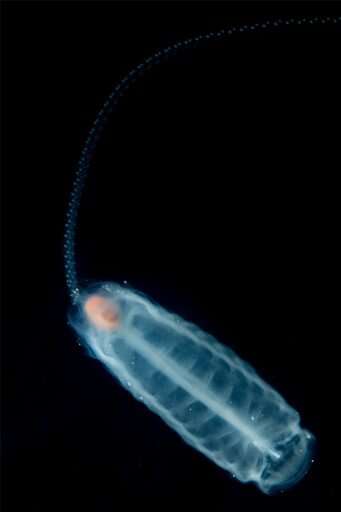Florida State University researchers have more insight into a strange sea creature found in oceans around the world and what their presence means for the health of a marine ecosystem.
Scientists have thought that salps—small marine organisms that look like clear, gelatinous blobs—competed for resources with krill, shrimp-like creatures that are an important food source for many marine animals. But new research published in Limnology and Oceanography suggests that salps are actually competing for food with an organism known as a protist.
“These fascinating and bizarre animals are becoming more abundant in the vast and warming Southern Ocean, so we sought to understand how their presence changes marine ecosystems,” said Michael Stukel, a researcher with FSU’s Center for Ocean-Atmospheric Prediction Studies and an associate professor in the Department of Earth, Ocean and Atmospheric Science.
Though salps might resemble jellyfish, they are one of the earliest examples of chordates to evolve, and therefore more closely related to humans.
These organisms live in oceans around the world and feed on phytoplankton. When their food source is abundant, salps rapidly multiply with the help of an unusual reproductive cycle, forming large blooms made of thousands of organisms. They remove carbon dioxide from the atmosphere by eating algae and then compacting them into tiny pellets that sink to the bottom of the ocean.
Salps are also a food source for some marine animals, but they don’t provide much nutrition. Their importance to the marine food web is eclipsed by krill, which are nutritious food for all sorts of animals, from tiny anchovies to enormous whales. The old theory was that salp blooms crowded out krill, leading to more carbon sequestration but less food for marine organisms.
Instead, salps are probably replacing miniscule protists that are not an important food source for large organisms in the ocean. Although salps are much larger than those protists, they feed on the same microscopic algae. Imagine an elephant that eats the same food as an ant, Stukel said.
To understand what size prey the salps were eating, the researchers built a circular tank and filled it with salps and seawater, which contained their prey. They measured the fluorescence glowing from the salps’ prey living in the water and tracked how it changed over time to understand what size prey were being eaten.
Because the protists are the same size as their prey, they needed to use a different method to see what size prey they were eating. The researchers filled one bottle with seawater, which held a typical amount of protists and prey, and another with diluted seawater, which decreased the frequency with which predator and prey met. After 24 hours, they could use the same fluorescence measuring technique to see what kind of prey the protists ate.
Learning that salps are likely competing with protists, and not with krill, is reason to rethink the role of salp blooms in the ocean ecosystem.
“If we get more of these really weird organisms, how is that going to change the way the ocean works—for everything in the ocean, but also for humans?” Stukel said. “Our results suggest that salps are not even really competing with krill. They’re going to be replacing protists, so if that happens, you’ll get a lot more carbon sequestration and you’ll probably even get a little bit more food availability, because although salps are not as good a prey as krill, they’re still better prey than protists.”
Less nutritious diet on offer for Southern Ocean fish
More information:
Michael R. Stukel et al, Size‐specific grazing and competitive interactions between large salps and protistan grazers, Limnology and Oceanography (2021). DOI: 10.1002/lno.11770
Provided by
Florida State University
Citation:
Researchers uncover new role for strange organisms in ocean food web (2021, May 19)
retrieved 19 May 2021
from https://phys.org/news/2021-05-uncover-role-strange-ocean-food.html
This document is subject to copyright. Apart from any fair dealing for the purpose of private study or research, no
part may be reproduced without the written permission. The content is provided for information purposes only.



